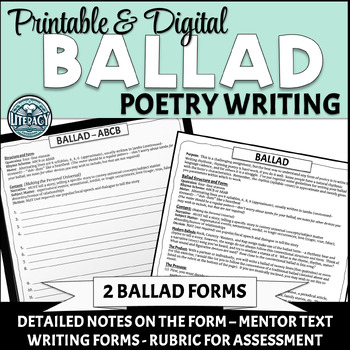Ballad - Poetry Writing - Poem Writing Form to Guide Process
- PDF
- Google Apps™

Also included in
- This Reading and Writing Ballads Bundle includes two of my most popular products: Ballad Writing and Medieval Ballads.Price $7.50Original Price $10.50Save $3.00
- Writing classic poems is perfect for ANY poetry unit, or poetry-writing can be integrated into various units throughout the year. You won't want to wait until April for National Poetry Month! These ten poetic forms provide students experience with writing the 10 most popular classic poetry structurePrice $30.00Original Price $40.00Save $10.00
Description
Do your students like to write songs? If you're studying ballads, would they want to write their own?
This poetry-writing exercise for writing a ballad gives students all the structure they need for writing a story and setting it to verse. Students will have fun writing rhyming poems and sharing with their classmates. Because everything is done for you, this no-prep print or digital resource is a lesson you can use TODAY! This also works well as an emergency substitute lesson plan and should take students 90 minutes (minimum) to complete.
This lesson includes
⭐ an assignment sheet with a detailed description of the process,
⭐ a writing form sheet to help students follow the format of a ballad,
⭐ a product-specific rubric to assess the student-written poem, and
⭐ examples (professional & student-written) to help students get started.
This is a rigorous poetry-writing activity for students and can easily integrated into a novel study or any poetry unit.
I have used this in conjunction with teaching Medieval and Modern Ballads in British poetry and as an option for a creative writing class. Writing your own ballad is helpful for assisting students as they write their own creations.
How to get TPT credit to use on future purchases:
Please go to your “My Purchases” page (you may need to login). Beside each purchase you'll see a Provide Feedback button. Simply click it and you will be taken to a page where you can give a quick rating and leave a short comment for the product.
Each time you give feedback, TPT gives you feedback credits that you use to lower the cost of your future purchases.
I value your feedback greatly as it helps me determine which products are most valuable for your classroom so I can create more for you.
Be the first to know about my new discounts, freebies and product launches:
Look for the green star next to my store logo and click it to become a follower, or CLICK HERE! You will now receive email updates about this store.
Thank you for visiting my store!
Melinda @TheLiteracyCookbook
TheLiteracyCookbook@gmail.com







